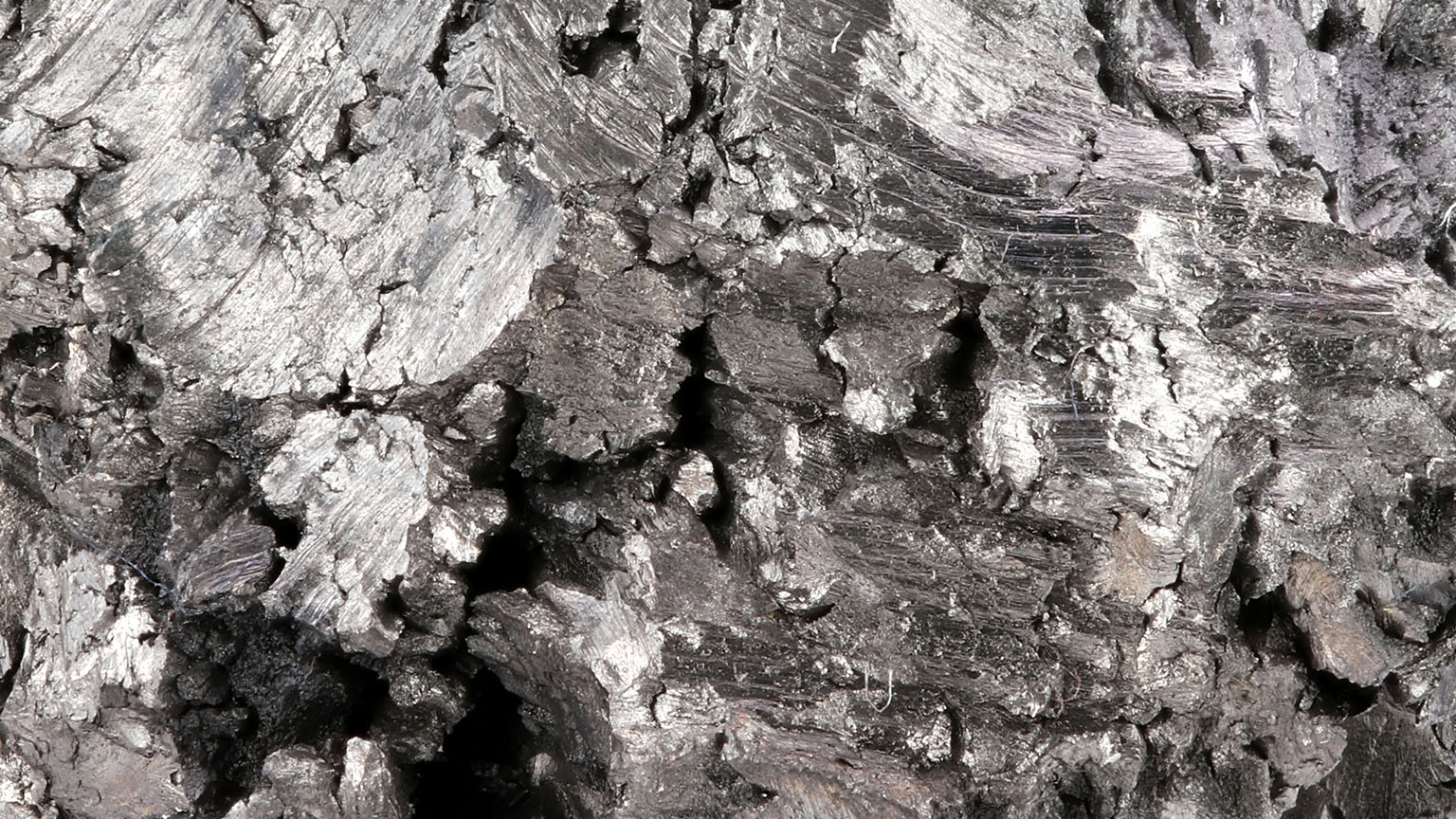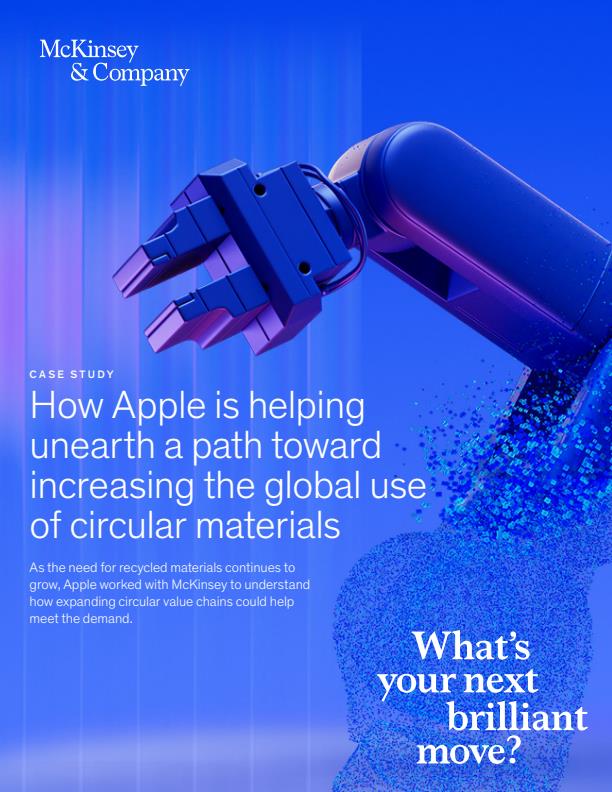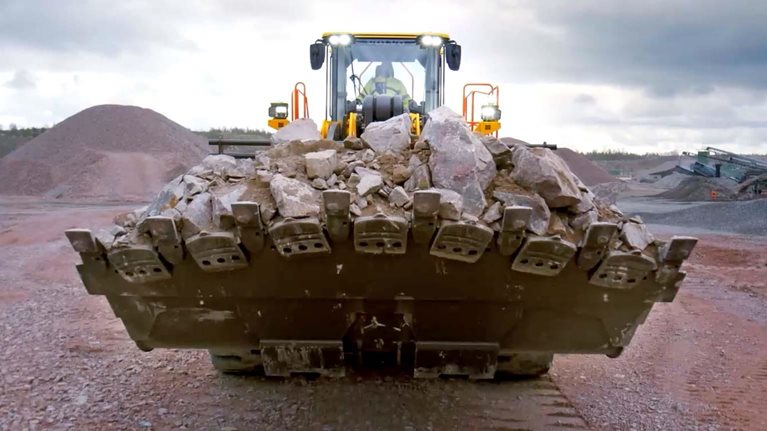Circular pathways as a source for sustainable materials
The smartphone in your pocket contains aluminum, copper, rare earth elements, and several other critical materials. They’re the same materials critical to the renewable energy transition, powered by technologies such as lithium batteries and electric vehicles.
But making and processing these materials for use across multiple industries, such as appliances, accounts for around 20 percent of all global greenhouse gas emissions. As the transition to a low-carbon future progresses, how can manufacturers build more sustainable technologies when the materials used to make them are so emission-heavy? What role can lower-carbon recycled materials play in meeting projected demand increases? And as a result: What are the total available secondary supply markets of key materials, and how can they be effectively unlocked?
Apple, a longtime leader in sustainable practices, sees the opportunity in circular materials and in 2017 first set the ambition to one day make its products using only 100 percent recycled and renewable materials. Use of circular materials lowers overall emissions, circumvents the added pollution and energy consumption from mining and refining new materials, and helps diversify sourcing by tapping into local and home markets. In 2024, 24 percent of the materials shipped in Apple products, by weight, came from recycled sources.
Circularity and decarbonization go hand in hand. Our work to use more recycled materials in our products not only reduces our reliance on extractive processes like mining, but it also brings us closer to our goal to be carbon neutral across our entire footprint by 2030.
Sarah ChandlerApple Vice President of Environment and Supply Chain Innovation
Circular materials also align with Apple’s ambitious goal of becoming carbon neutral across scope 1, 2, and 3 emissions by 2030; reducing emissions 75 percent compared with its 2015 baseline; and investing in high-quality carbon removal solutions for the remaining emissions. To help get there, Apple is driving circularity across all material supply chains, recognizing that it takes industry players and policy makers near and far to collaborate and incentivize scaling robust circular materials ecosystems and value chains.
To scale its efforts—and help identify broader market opportunities for decarbonization and circularity—Apple worked with McKinsey to realize a deeper understanding of circular value chains across multiple industries for materials like copper, aluminum, and rare earth elements, among others. To help strengthen broader industry momentum for circular materials, Apple and McKinsey have chosen to make a number of quantitative research findings publicly available, calling for industry partners to help increase the overall use of circular materials.
Identifying opportunities to unlock circular materials
Apple experts from across functions, including operations, engineering, and environmental teams, collaborated with McKinsey to complement existing work to further explore the current landscape and new opportunities for circular materials: What materials get lost in production after reaching end-of-life; which untapped scrap pools have the most potential; and what actions, alliances, and regulatory conditions are needed to get there.
MineSpans market intelligence services
Offer a comprehensive outlook of the metals and mining industries. Built by McKinsey’s commodities experts, and covering 10,000+ global assets across 15+ commodity value chains, our detailed bottom-up supply and demand forecasts, granular cost models, and ESG data empower decision makers.
Apple wanted to make these results as practical, concrete, and actionable as possible by identifying measures to unlock these untapped materials, looking to understand and share what exact scrap reservoirs exist by region and industry, what form the scrap comes in, and how to operationally unlock it.
To get a granular view of the materials market, one element of the work involved use of MineSpans, a McKinsey tool that pools data on all the mines in the world, using supply-and-demand models, carbon footprints, and scrap pool data. This data complemented Apple’s own work in key material value chains and their circularity opportunities, supply-and-demand dynamics, and the products that contain these materials, such as copper in electrical devices and underground cables.
We want to see markets for recycled materials that are as vibrant as those for primary materials. No single company can make that happen on their own. ...Collaboration is a force multiplier.
Sarah ChandlerApple Vice President of Environment and Supply Chain Innovation
“Tapping new material pools requires not only a deep understanding of several material value chains,” says McKinsey Partner Peter Spiller. “It also necessitates that players along the chain work together to effectively address existing barriers.”
The research is helping Apple identify further ways to unlock these materials, such as e-waste management and regulatory measures, ensuring materials that would otherwise be lost can be recovered and recycled. The goal is for industry players and policy makers to forge a viable path toward recovering them.
In this spirit of collaboration, Apple is actively rallying partners and adjacent industries to drive change across materials supply chains. Now that they’ve helped build a recycled material end-to-end market perspective within the electronics industry, Apple is looking to team up with other off-takers with shared ambitions, as well as materials producers and equipment manufacturers working on ways to disassemble, sort, or recover materials. This effort is part of the World Business Council for Sustainable Development’s Critical Materials Collective initiative. From offtake agreements to scrap collection, this collaborative approach ensures the entire ecosystem works together toward sustainability and circularity goals.
“We want to see markets for recycled materials that are as vibrant as those for primary materials,” says Sarah. “No single company can make that happen on their own, but when we combine our purchasing power with others we can have an outsized impact. Collaboration is a force multiplier.”
Key circular material insights and a call to action
The resulting in-depth analysis and research revealed how critical materials are produced and collected and where they end up today, with circular materials coming from two distinct sources: pre-consumer scrap generated during the manufacturing process and post-consumer scrap from products no longer in use—both essential to increasing material supply.
Challenges and opportunities for each circular materials value chain were mapped and concrete actions needed to unlock untapped pools outlined. The following provides some examples of these insights while more can be found in our materials-specific deep dives.



Copper
The global copper market is expected to fall short by roughly four million metric tons or roughly 10 percent in 2035 because of growing demand and limited additions in primary supply. At the same time, four to five million metric tons of copper scrap will be lost every year.
Increasing the collection, disassembly, and recycling of consumer electronics goods in the United States, Latin America, and Asia alone could unlock 1.2 million metric tons of circular copper supply a year, closing 30 percent of the supply-and-demand gap for copper while simultaneously reducing materials emissions.
Expanding such efforts to other sectors, like transport, machinery, and construction could unlock another half million metric tons of copper.
Aluminum
Aluminum is a prime candidate for recycling with 75 percent of all aluminum ever mined as bauxite still in use today. Recycled aluminum offers the potential of up to 95 percent savings on CO2 emissions as compared to using mined material. Through Apple’s innovation and sourcing of post-industrial and post-consumer recycled material, Apple has reduced aluminum-related emissions by 76 percent since 2015, representing less than 7 percent of product manufacturing footprint in 2024 compared with 27 percent in 2015. Despite this encouraging data, because of limitations in today’s recycling technology, a significant amount of aluminum scrap is not effectively processed to recover specific alloys. Across applications, due to current market sorting practices, more than half of all collected aluminum scrap ends up in mixed scrap pools, limiting the ways in which it can be recycled.
This issue could be addressed by deploying more advanced sorting technologies recently available at scale. Some remelters are already investing, while clearer demand signals from off-takers could help unlock further capacity for circular aluminum. For example, under the World Business Council for Sustainable Development (WBCSD)’s Critical Materials Collective, Apple is collaborating with other industry players to advance joined-up circular aluminum value chains.
Rare earth elements
Understanding materials-specific value chains in depth does not always yield immediately actionable opportunities to advance circularity. For rare earth elements, opportunities today are more limited.
In 2035, most post-consumer material will come from appliances and electronics. In this context, rare earth element magnets could be challenging to recover given the lack of scalable and cost-effective dismantling technologies today. Recycled supply from post-consumer sources could be as low as 5 percent of consumption, exacerbating supply challenges. At the same time, demand for rare earth elements is expected to triple as the production of battery electric vehicles and wind-turbine motors grows over the next decade.
To scale quickly enough to solve for this challenge in the short term, players will need to invest in accelerating research and development of the technology needed, much of which still must be built and proven at industry scale. For example, Apple has invested in recycling innovations including Taz, a machine that separates magnets from audio modules to recover rare earth elements and Dave, a robot that disassembles Taptic Engines on Apple devices to recover valuable rare earth magnets, tungsten, and steel. In July 2025, Apple announced a deal with MP Materials for rare earth magnets that includes plans for an all-new recycling facility capable of taking in recycled rare earth feedstock and reprocessing it for use in Apple products.
“When we first set out to make magnets using recycled rare earth elements, it felt like an almost impossible task,” says Sarah. “Today, nearly all of the magnets in our products are made with 100 percent recycled rare earths, and there’s more work to do. With circularity, you often have to start by proving what’s possible.”
Collaboration across the value chain is a long-term approach to help solve this challenge. For example, producers and original equipment manufacturers help recyclers focus their efforts by providing transparency on magnet locations such as Apple’s recycler guides—an effort regulators now require.
Such insights help effectively devise strategies for unlocking and making use of untapped circular materials pools. “Circularity has the potential to address emissions across industries and value chains,” says McKinsey Senior Partner Michel van Hoey. “But to increase recycled content in their products, players need a detailed understanding of current barriers and unlocks to tap new secondary pools instead of competing for already scarce supply.”
Tapping new material pools requires not only a deep understanding of several material value chains. It also necessitates that players along the chain work together to effectively address existing barriers.
Peter Spiller McKinsey Partner
Using these industry insights, Apple hopes to fuel alliance-building efforts that bring together various stakeholders, including aluminum and copper producers, collectors, and equipment manufacturers. These collaborations aim to create comprehensive value chains for recycled materials, ensuring a steady supply of high-quality recycled materials.
“We’re always striving to share our experience and learn from others in our environmental work, to ensure our impact can ripple beyond Apple and across other industries and sectors,” says Sarah. “Circularity is no different—we can achieve so much more when we partner with others.”
Get in touch

Peter Spiller
Frankfurt

Michel Van Hoey
Luxembourg

Yael Taqqu
New York
Related Case Studies
Accelerating decarbonization across the farming supply chain
Adding a powerful new tool to the field mechanic’s toolbelt: AI
How a UAE bank transformed to lead with AI and advanced analytics




